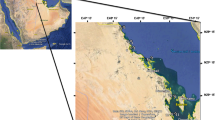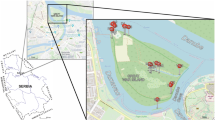Abstract
Sediment samples from the coastal zone of the Gulf of Suez contain a variety of organic compounds from anthropogenic and natural sources. A total of 12 surface samples of bottom sediments were collected with an Ekman grab sampler along an off-shore transect south of Ras Abu el-Darag. The samples were extracted with a mixture of dichloromethane and methanol (3:1 v/v) after drying and sieving through 250 μm mesh. The extracts were derivatized and analyzed by gas chromatography–mass spectrometry in order to characterize the chemical composition and sources of the organic components. Marine with minor terrestrial biota were the major natural sources of organic tracers and included n-alkanoic acids, sterols and saccharides (5.7–76.7%). Anthropogenic sources, from petroleum related activities, detergent usage for spill cleaning and littering, are indicated by the presence of n-alkanes with carbon preference index ≤1.0, hopanes, steranes, unresolved complex mixture of branched and cyclic hydrocarbons, alkyl nitriles, alkamides and plasticizers. Their total relative concentrations ranged from 23.3 to 97.3% of the total extracts. Petroleum residues from natural seepage may also be part of these hydrocarbons. The levels of anthropogenic inputs decrease from about 94% in coastal zone sediments to about 20% in sediments from the reef front.





Similar content being viewed by others
References
Abril JM, Abdel-Aal MM (2000) Marine radioactivity studies in the Suez Canal, part I: hydrodynamics and transit times. Estuar Coast Shelf Sci 50:503–514
Al-Mutlaq KF, Rushdi AI, Simoneit BRT (2007) Organic compound tracers of soil and sand particles during summer in the metropolitan area of Riyadh, Saudi Arabia. Environ Geol 52:559–571
Anderson L, Dyrssen D (1994) Alkalinity and total carbonate in the Arabian Sea. Carbonate depletion in the Red Sea and Persian Gulf. Mar Chem 47:195–202
Barbier M, Tusseau D, Marty JC, Saliot A (1981) Sterols in aerosols, surface microlayer and subsurface water in the north-eastern tropical Atlantic. Oceanol Acta 4:77–84
Bauer R, Remiger P, Wagner H (1989) Alkamides from the roots of Echinacea angustifolia. Phytochemistry 28:505–508
Brassell SC, Eglinton G, Maxwell JR (1983) The geochemistry of terpenoids and steroids. Biochem Soc Trans 11:575–586
Brooks P, Maxwell JR (1974) Early stage fate of phytol in a recently deposited lacustrine sediment. In: Tissot B, Bienner F (eds) Advances in organic geochemistry 1973. Technip, Paris, pp 977–991
Bryan GW (1976) Some aspects of heavy metal tolerance in aquatic organisms. In: Lockwood APM (ed) The effects of pollutants on aquatic organisms. Cambridge University Press, Cambridge, pp 7–34
Dembitsky VM, Shkrob I, Rozentsvet OA (2000) Fatty acid amides from freshwater green alga Rhizoclonium hieroglyphicum. Phytochemistry 54:965–967
Dicks B (1987) Pollution. In: Edwards AJ, Head SM (eds) Red sea: key environments. Pergamon Press, Oxford, pp 383–404
Didyk BM, Simoneit BRT, Brassell SC, Eglinton G (1978) Organic geochemical indicators of palaeoenvironmental conditions of sedimentation. Nature 272:216–222
Edwards AJ (1987) Climate and oceanography. In: Edwards AJ, Head SM (eds) Red sea, key environments series. Pergamon Press, Oxford, pp 45–69
Edwards AJ, Head SM (eds) (1987) Red sea, key environments series. Pergamon Press, Oxford
Eglinton G, Hamilton RJ (1967) Leaf epicuticular waxes. Science 156:1322–1335
El-Sikaily A, Khaled A, El Nemr A, Said TO, Abd-Alla AMA (2003) Polycyclic aromatic and aliphatic hydrocarbons in the coral reef skeleton of the Egyptian Red Sea coast. Bull Environ Con Tox 72:1252–1259
Ensminger A, van Dorsselaer A, Spyckerelle C, Albrecht P, Ourisson G (1974) Pentacyclic triterpenes of the hopane type as ubiquitous geochemical markers: origin and significance. In: Tissot B, Bienner F (eds) Advances in organic geochemistry 1973. Technip, Paris, pp 245–260
Faure P, Elie M, Mansuy L, Michels R, Landais P, Babut M (2004) Molecular studies of insoluble organic matter in river sediments from Alsace-Lorraine (France). Org Geochem 35:109–122
Giner J-L, Li X (2001) Stereospecific synthesis of 24-propylcholesterol isolated from the Texas brown tide. Tetrahedron 56:9575–9580
Grosjean E, Logan GA (2007) Incorporation of organic contaminants into geochemical samples and an assessment of potential sources: examples from geoscience Australia marine survey 5282. Org Geochem 38:853–969
Hedges JI, Keil RG, Benner R (1997) What happens to terrestrial organic matter in the ocean? Org Geochem 27:195–212
Hoefs MJL, Rijpstra WIC, Sinninghe Damsté JS (2002) The influence of oxic degradation on the sedimentary biomarker record I: evidence from Madeira Abyssal Plain turbidites. Geochim Cosmochim Acta 66:2719–2735
International Union for Conservation of Natural Resources (IUCN) (1987a) Yemen Arab Republic: marine conservation survey, vol 1. Distribution of habitats and species along the YAR coastline. IUCN Red Sea and Gulf of Aden Environmental Program/TMRU, York
International Union for Conservation of Natural Resources (IUCN) (1987b) Yemen Arab Republic: marine conservation survey, vol 2. Distribution of habitats and species along the YAR coastline. IUCN Red Sea and Gulf of Aden Environmental Program/TMRU, York
Jordan RE, Payne JR (1980) Fate and weathering in petroleum spills in the marine environment. Ann Arbor Science, Ann Arbor, p 174
Kassim TA, Simoneit BRT (1993) Detergents: a review of the nature, chemistry and behavior in the aquatic environment: chemical composition and analytical techniques. Crit Rev Environ Sci Technol 23(4):325–376
Khaled A, El Nemr A, Said TO, El-Sikaily A, Abd-Alla AM (2004) Polychlorinated biphenyls and chlorinated pesticides in mussels from the Egyptian Red Sea coast. Chemosphere 54:1407–1412
Lehninger AL (1970) Biochemistry. Worth Publishers, Inc, New York, 833 p
Malins DC (ed) (1977) Effects of petroleum on Arctic and Subarctic marine environment and organisms, vol 1. Nature and fate of petroleum. Academic, New York, p 321
Morcos SM (1970) Physical and chemical oceanography of the Red Sea. Oceanogr Mar Biol 8:73–202
PERSGA/SAP (2001a) Strategic Action Programme (SAP) for the Red Sea and the Gulf of Aden: navigation risk assessment and management plan. World Bank, Washington, 103 p
PERSGA/SAP (2001b) Strategic Action Programme (SAP) for the Red Sea and the Gulf of Aden: country reports. World Bank, Washington, 205 p
Philp RP (1985) Biological markers in fossil fuel production. Mass Spectrom Rev 4:1–54
Ricking M, Schwarzbauer J, Franke S (2003) Molecular markers of anthropogenic activities in sediments of Havel and Spree Rivers (Germany). Water Res 37:2607–2617
Rushdi AI, Ba-Issa AA, Ba-Bagi A (1991) Preliminary investigations of oil pollution along the Red Sea coast of Yemen. In: Proceedings of the seminar on the status of the environment in the Republic of Yemen, Sana’a, 1–5 January 1991
Rushdi AI, Al-Mutlaq KF, Simoneit BRT (2005) Sources of organic compounds in fine soil and sand particles during winter in the metropolitan area of Riyadh, Saudi Arabia. Arch Environ Contam Toxicol 49:457–470
Rushdi AI, Al-Zarban S, Simoneit BRT (2006) Chemical compositions and sources of organic matter in fine particles of soils and sands from the vicinity of Kuwait City. Environ Monit Assess 120:537–557
Schwarzbauer J, Heim S (2005) Lipophilic organic contaminants in Rhine River, Germany. Water Res 39:4735–4748
Sheppard CRC (ed) (1992) Marine ecology of the Arabian region. Academic, New York, p 359
Sheppard C, Price A, Roberts C (1992) Marine ecology of the Arabian region. In: Sheppard CRC (ed) Marine ecology of the Arabian region. Academic, New York, pp 230–256
Simoneit BRT (1977) The Black Sea, a sink for terrigenous lipids. Deep Sea Res 24:813–830
Simoneit BRT (1980) Eolian particulates from oceanic and rural areas—their lipids, fulvic and humic acids and residual carbon. In: Douglas AG, Maxwell JR (eds) Advances in organic geochemistry 1979. Pergamon, Oxford, pp 343–352
Simoneit BRT (1984) Organic matter of the troposphere-III. Characterization and sources of petroleum and pyrogenic residues in aerosols over the Western United States. Atmos Environ 18:51–67
Simoneit BRT (1985) Application of molecular marker analysis to vehicular exhaust for source reconciliation. Int J Environ Anal Chem 22:203–233
Simoneit BRT (1986) Cyclic terpenoids of the geosphere. In: Johns RB (ed) Biological markers in the sedimentary record. Elsevier, Amsterdam, pp 43–99
Simoneit BRT, Mazurek MA, Reed WE (1983) Characterization of organic matter in aerosols over rural sites: phytosterols. In: Bjorøy M et al (eds) Advances in organic geochemistry 1981. Wiley, Chichester, pp 355–361
Simoneit BRT, Elias VO, Kobayashi M, Kawamura K, Rushdi AI, Medeiros PM, Rogge WF, Didyk BM (2004) Sugars—dominant water-soluble organic compounds in soils and characterization as tracers in atmospheric particulate matter. Environ Sci Technol 38:5939–5949
Sinninghe Damsté JS, Rijpstra WIC, Reichart G (2002) The influence of oxic degradation on the sedimentary biomarker record II: evidence from Arabian Sea sediments. Geochim Cosmochim Acta 66:2737–2754
Topping G (1976) Sewage and the sea. In: Johnstone R (ed) Marine pollution. Academic, London, pp 301–351
UNEP (1985) Management and conservation of renewable marine resources in the Red Sea and Gulf of Aden. UNEP Regional Seas Report and Studies No. 64, UNEP, Nairobi
Volkman JK (1986) A review of sterol markers for marine and terrigenous organic matter. Org Geochem 9:83–99
Volkman JK, Farrington JW, Gagosian RB (1983) Lipid composition of coastal marine sediments from the Peru upwelling region. In: Bjorøy M et al (eds) Advances in organic geochemistry 1981. Wiley, Chichester, pp 228–240
Wenninck CJ, Nelson-Smith A (1979) Coastal oil pollution study for the Gulf of Suez and the Red Sea coast of the Republic of Egypt, vol 2. IMCO, London
Author information
Authors and Affiliations
Corresponding author
Additional information
Tarek A. T. A. Kassim is deceased.
Rights and permissions
About this article
Cite this article
Rushdi, A.I., Kassim, T.A.T.A. & Simoneit, B.R.T. Organic tracers in sediments from the coastal zone of Ras Abu el-Darag, Gulf of Suez. Environ Geol 58, 1675–1687 (2009). https://doi.org/10.1007/s00254-008-1668-3
Received:
Accepted:
Published:
Issue Date:
DOI: https://doi.org/10.1007/s00254-008-1668-3




